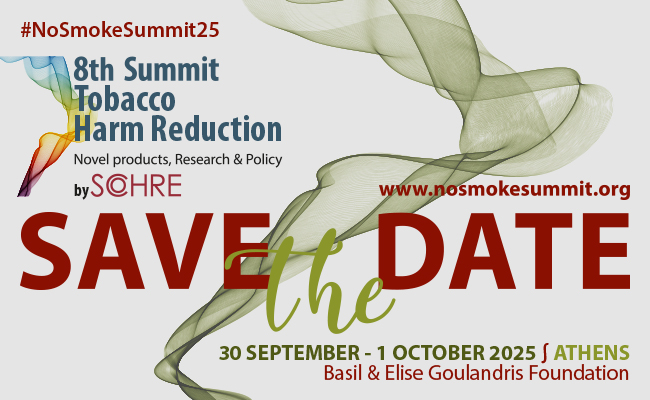In the last session of the 7th Summit on Tobacco Harm Reduction by SCOHRE, the board members of the Association reaffirmed SCOHRE’s vision and presented 10 proposals aimed at combating the smoking epidemic and its harmful effects.
Here is the full text of the 10 Public Health Proposals on Smoking Control
1 – Awareness and Informed Decisions
Making an informed decision involves two key aspects: first, having access to the necessary information, and second, using that information to assess what is personally significant in relation to the decision at hand. Decision aids can support smokers in this process by helping them make informed choices. These aids typically consist of two components: (1) providing balanced, objective information, and (2) utilizing value clarification methods, which assist individuals in identifying what they personally find important regarding the decision in question.
2 – Bioethics and Human Rights
Human rights should be central to policy decisions on nicotine products. International bioethics protocols emphasize the importance of informed consent and consumer empowerment—ultimately, people matter. Policies must acknowledge the significant differences in risk levels and support users in reducing harm. Furthermore, as knowledge advances, these policies should be continuously updated to reflect new insights.
3 – Health Literacy (Education)
Educating both health professionals and smokers plays a crucial role in enhancing the effectiveness of tobacco control efforts, directly impacting public health. For health professionals, it is essential to offer specialized training seminars, practical counseling training, online courses, and information on pharmaceutical preparations as well as new nicotine delivery devices. These professionals are in a position to intervene proactively and bolster smokers’ determination to quit. Well-trained professionals can significantly increase the success of cessation interventions by reducing the likelihood of relapse. At the same time, smokers also need to be equipped with the necessary tools and support to quit smoking. This can be achieved through counseling services, mobile cessation programs, public information campaigns, and educational materials such as brochures, videos, and leaflets. Such resources further enhance the overall effectiveness of tobacco control efforts.
4 – Network & Collaboration
Cigarette smoking is a global challenge affecting 1.3 billion people, resulting in 8 million deaths each year from smoking-related diseases. Sharing experiences and best practices between countries can lead to the implementation of modern, comprehensive, and effective public health strategies to combat smoking. To be realistic and successful, these strategies must include all three levels of prevention: health education, secondary prevention (social and fiscal policy, screening), and tertiary prevention (limiting disease complications, harm reduction, and improving patients’ quality of life). The case of Sweden—where only about 5% of the population smokes—serves as epidemiological proof that an effective public health strategy can be implemented. International collaboration among experts, using platforms like SCOHRE, should aim to create a unified, strong stance that promotes a shift in the WHO’s approach to a more pragmatic one, grounded in emerging scientific evidence.
5 – Prevention
Preventing the initiation of smoking and reducing exposure to smoke are central to combating the smoking epidemic. Evidence shows that prevention can take the form of policy-level measures, such as increasing tobacco product taxation; enforcing stricter regulations on who can purchase tobacco; controlling where and how these products can be sold and used; and imposing advertising restrictions alongside mandatory health warnings on packaging. Prevention efforts must also occur at home, in schools, and within communities. While educating about health risks alone has not proven effective, successful evidence-based interventions focus on reducing or delaying the initiation of smoking and other substance abuse. These interventions work by addressing vulnerability factors and reinforcing protective factors against risky and addictive behaviors, particularly to protect youth. Strategies include reducing exposure to family smoking, educating about peer influence, addressing domestic violence, targeting lower socioeconomic areas or those with a high density of tobacco outlets, supporting participation in team sports, and encouraging cultural and creative activities that promote self-esteem and assertiveness.
6 – Robust Regulatory Framework (Legislation) to Ensure Fairness
There is a vast differential in both risks and addictiveness of nicotine delivery systems, largely determined by whether consumers are inhaling smoke. Regulations should thus treat nicotine products in a risk-proportionate way, tax laws should be similarly geared to risk, and there should be significant regulatory efforts to empower consumers to make informed decisions. Regulations should also be updated regularly to reflect the emergence of new and changed products and current scientific knowledge, and these laws should robustly defend consumers from misinformation.
7 – Evidence-Based Policy, Unobstructed Research & Transparency in Scientific Data
Designing an evidence-based and transparent smoking cessation policy is essential to protecting public health, effectively addressing nicotine dependence, and reducing the harmful consequences of smoking. A health system that invests in scientific knowledge while ensuring impartial and unbiased research will be more effective and equitable. Evidence-based policy provides a solid framework for both prevention and treatment. Furthermore, a health system that actively promotes and integrates new scientific findings guarantees that smokers receive the highest standard of care. Our efforts are focused on informing all stakeholders about existing evidence, encouraging new research, and generating further evidence on Tobacco Harm Reduction and its potential to mitigate the detrimental effects of smoking. Establishing a global network of experts will help produce robust evidence that can drive health policies and regulations rooted in science rather than emotion or dogma.
8 – Smoking Cessation Is the Steppingstone to Fight Smoking
Smoking cessation is the most critical and effective intervention in the broader strategy to prevent and reduce smoking-related morbidity and mortality. When evaluating the impact of tobacco dependence, few other conditions present such a severe combination of lethality, prevalence, and neglect, despite the availability of effective interventions. The ongoing devastation and immense costs caused by global tobacco addiction make tobacco control and smoking cessation urgent public health priorities. Smoking cessation is arguably the most powerful and cost-effective intervention for the primary and secondary prevention of smoking-related disease, disability, and death. To effectively address the tobacco pandemic, we must end years of neglect by adopting best practices and implementing systematic approaches to identifying and treating smokers. By prioritizing cessation efforts, healthcare providers can significantly reduce the long-term health impacts of tobacco use.
9 – Differential Taxation to Drive Behavioural Change
Reducing the prevalence of cigarette smoking should be pursued through multiple parallel strategies. One of the most effective methods is health-promoting fiscal policy, which involves taxing tobacco and nicotine-containing products based on the principle of ‘less harm, less tax.’ The assessment of harmfulness should include data on the content and amount of toxic substances released, and this information should be evaluated and made public by a designated state authority using marketing authorization documents for cigarettes and other nicotine products. Additionally, a continuously updated analysis of the actual clinical harm—such as symptoms and disease development—should be maintained. This approach would restrict access to all products in this category, with a particular focus on those with the highest toxicity. Ultimately, this would lead to reduced consumption, which is likely to result in lower health losses for society.
10 – Tobacco Harm Reduction a Mainstream Strategy for Public Health Protection
Smoking policies have traditionally focused on prevention and cessation, but recent data show they have not sufficiently reduced smoking rates in many countries. While essential, these strategies alone do not address the needs of those unable to quit. Tobacco Harm Reduction (THR) offers scientifically backed, lower-risk alternatives to cigarettes that can significantly reduce the health burden of smoking. Products like vaping devices, nicotine pouches, snus, and heated tobacco can replace cigarettes and improve health outcomes for those who switch. Sweden, with a smoking prevalence of just 5%, is a successful example of a THR-focused strategy using snus. Given the global toll of smoking-related diseases, THR is a pragmatic approach that recognizes nicotine addiction and the varying risks of tobacco products. Countries like the UK, New Zealand, Canada, France, and the USA are already seeing positive results by incorporating THR into their anti-smoking efforts. We advocate for THR to become a mainstream public health strategy.

